Great Albums: Britpop
While America was suffering through grunge
the U.K. underwent a lush pop music revival. How did a few bands
transforming club music with live instruments lay the foundation
for Oasis? Find out here...
March 19, 2005
Britpop arose from the sonic remnants of
post-punk bands such as Joy Division and The Smiths. Northern
England was saturated with illicit substances that influenced
many musicians to shed the gloomy and pretentious sounds of
their predecessors for a dance beat-charged revival of
traditional British pop styles that emerged during the '60s
British Invasion. Soon, drug-popping club kids were picking up
guitars and forming bands like the Happy Mondays, who in turn
influenced others, like The Stone Roses. Bands such as these
mixed psychedelia and jangle pop into a formula that lead to a
short-lived neo-British Invasion of America, which delivered
such bands as Jesus Jones and EMF.
Once the party was over, acts began to emerge
that seemed to take seriously the carrying of the traditional
musical torch. Suddenly hard-hitting guitar-based pop dominated
the popular British conscience, giving way to a resurgence of
glam rock, atmospheric psychedelic rock, and new romanticism.
All this was happening during the era of grunge in America.
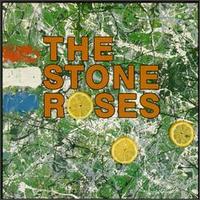
The Stone Roses - The Stone Roses
(1989)
In 1989, The Stone Roses released The
Stone Roses, which emerged during an era heavily
saturated by UK house and acid house. This eponymous album
managed to fuse Manchester and London's affinities for
dance-oriented beats with sonic styles reminiscent of eras
past, such as psychedelic rock and '60s pop-guitar
structures. Aside from defining a sound that would be tagged
"baggy," The Stones Roses literally opened the door for the
commercial viability of acts like Inspiral Carpets,
Charlatans UK, Happy Mondays, and arguably the whole of the
shoegazer movement.
The UK charts were very kind to The Stone
Roses in 1990. Four of the band's singles landed in the top
40, and the group went from playing small clubs to selling
out stadiums, with attendance climbing as high as 30,000.
Audiences were addicted to the narcotic-inspired pop
transmitted by The Stone Roses. Club hits, like "She Bangs
the Drums," "Fool's Gold," and "Elephant Stone," were
inserted among wall-of-sound psychedelia that treaded on
ground being tilled by the likes of Ride and My Bloody
Valentine.
The Stones Roses suffered from the weight
of their success, however. Legal battles with the label, as
well as internal strife, led to a five-year void between the
band's phenomenal debut and its sophomore release. Shortly
after The Second Coming was released, The Stone
Roses disbanded. Though critics and fans alike dished cold
reviews upon the release, we here at MP3.com agree the album
is worth a listen.
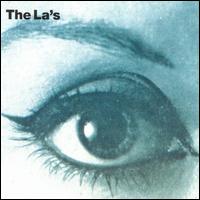
The La's - The La's (1990)
This is the LP in this list with the most
mysterious background. The La's debut and final album was
not even supposed to be released to the public. According to
Lee Mavers, The La's eccentric front man, it was never
finished and remains to this day incomplete...and "rubbish."
The band's record company rushed to release the album in
1990, which then achieved critical and commercial acclaim
(only after Mavers supposedly attempted to rerecord it a
fifth time). According to La's lore, Mavers would only
record on original Abbey Road Studios' decks. When he still
couldn't get the sound he wanted, Mavers looked over the
equipment and made a comment about the decks not having
enough Abbey Road dust on them. (We're not kidding, folks.)
The album itself owes more to The Beatles
and The Hollies than to The Smiths. It's infectious,
optimistic, and short, just like its 1960s inspiration. The
stand out track, There She Goes, is a constant on
the radio to this day, and it supposedly single-handedly
pays for Mavers' reclusive lifestyle. supposedly
single-handedly pays for Mavers' reclusive lifestyle.
"Looking Glass," the album's closer, rivals The Stone Roses'
"I Am the Resurrection" as the genre's bloated, epic
masterpiece. The album's contribution to the genre is
immense once commented that he started Oasis to finish what
The La's had started.
Over the years, the myth of Mavers, who
has all but sequestered himself from the world, has been
built to grail-like proportions. Is he still recording? Is
it true that his new songs, which few have heard, are the
best thing to come out of Liverpool? We'll never know. We're
just going to have to settle for this one brilliant
album...and hope.
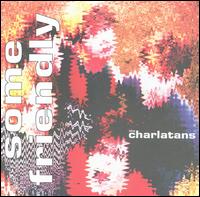
The Charlatans UK - Some Friendly
(1990)
Straight out of the gate, Charlatans UK
never received a fair shake. Firstly, the band was accused
of producing a carbon copy of the "Madchester sound," which
was defined by The Stone Roses and Happy Mondays. Secondly,
the group's name acted as an affirmation of the first point.
However, Some Friendly injected traditional British
Invasion elements into modern psychedelia, resulting in
dreamlike pop that was both immediately accessible and
sonically unique.
Some Friendly
flaunts a happy-go-lucky veneer, but lurking below the
surface are very melancholic songs. While the beat groove of
"The Only One I Know" remains the best-known song, tracks
like "Then" and "Sproston Green" provide clear insight into
the paranoid psychotropic excesses typified by the era. Of
course, just when you think the despondent guitar washes and
warm organ are carrying Some Friendly into some
post-chill-out lake of introspection, a track like "Polar
Bear" emerges with hypnotic dance-floor fury. But again, pay
attention to Tim Burgess' lyrics as they stand in stark
contrast to the omnipresent fun vibe. This album is
extremely deceptive and has, surprisingly, remained rather
fresh-sounding. The Charlatans UK would find themselves
diving deeper into the stereotypical mid '90s Britpop sound,
but this album remains a testament to the resurgence of '60s
psychedelic pop.

Blur - Parklife (1994)
Parklife
followed in the wake of Blur's sophomore release, Modern
Life Is Rubbish, which cemented and solidified the
group's position as heir to the Britpop revivalist throne.
The band didn't miss a beat. Parklife presents a
concept album that leads listeners through a living,
breathing museum of British rock history. With seamless
execution, Blur mimics styles defined by The Kinks, The
Small Faces, The Jam, and XTC.
The album was a phenomenon in the UK. The
sonic pastiche that Parklife created was both a
scathing social commentary and a celebration of English
tradition. Singer Damon Albarn lyrically sculpts a
multidimensional representation of modern English life that,
at times, matches the despair that forerunners such as Pink
Floyd created. Actually, on "Far Out" it sounds as if Albarn
has locked himself in a light-tight room assiduously
studying Syd Barrett's Madcap Laughs. Albarn's
lyricism is matched with astoundingly intelligent musical
backdrops. "To the End" calls to mind Beatles producer
George Martin mixing a Burt Bacharach tune, while "Girls &
Boys" mashes the disco-fried experimentations of the Cure,
circa 1995, with the seemingly vacuous fashion of Duran
Duran. In all honesty, Parklife borders on
perfection and deserves any and all praise tossed to it.
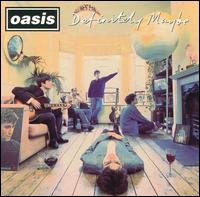
Oasis - Definitely Maybe
(1994)
Undeniably, when Americans think of
Britpop, they think of Oasis...and that usually ends the
discussion. The reasons for this revolve around two very
popular albums: Definitely Maybe and (What's
the Story) Morning Glory. While Glory is the
one that shot the band into superstardom, Definitely
Maybe is the better of the two. And along with early
'90s LPs from Blur and Suede, Oasis brought British guitar
rock back in to the mainstream. While many criticize the
band for its overt Beatles influences and haircuts, no one
denies Noel Gallager's songwriting, which, coupled with his
brother's trademark snarl, is definitely something to
remember.
While the infighting between the two
brothers and a rivalry with Blur would later take the
spotlight, Definitely Maybe was all about the
music. "Live Forever" and "Shakermaker," in particular, are
two of the best songs in the collection, and they stand up
much better than many of Glory's more popular
ballads. The album is also grittier than the band's later
work, and tracks like "Rock 'N' Roll Star" are at least
partially responsible for bringing crunch guitar out of a
grunge movement that had enveloped the world for the
previous half decade.
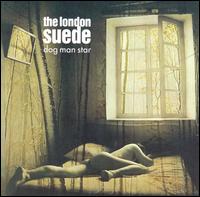
Suede - Dog Man Star (1994)
Our assumption is that many Suede fans ran
to their local record shop, purchased this album, ran home,
put it on, and repeatedly debated as to whether 33 or 45rpm
was the correct speed. Here, Suede trades in the
paint-by-numbers glam rock executed on its debut for sonic
tragedy. Dog Man Star borders on melodramatic
ridiculousness, as vocalist Brett Andersen delivers lyrics
penned while in the midst of a self-induced hermetic vision
quest. The album also marks the final appearance of founding
guitarist Bernard Butler, who departed prior to the work's
completion, which makes Dog Man Star's cohesiveness
all the more difficult to comprehend.
Every song on the album feels as though it
were being translated from Suede's collective dream
journey...as if the listener were not hearing it firsthand.
The vocal work is haunting, the guitar feverish yet distant,
and the general production rich with romanticism. This is an
album best listened to on a cold winter's night, next to a
fire, while you contemplate the lover who's escaped your
grasp.
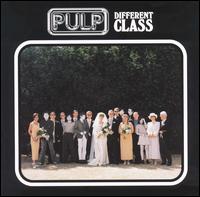
Pulp - Different Class
(1995)
A companion piece to Blur's Parklife,
Different Class covers similar territory in that it
focuses primarily on British social class and rule. Where it
differs, however, is in its overly thematic and theatrical
sonic tendencies. With a sound more similar to The
Phantom of the Opera than to a Beatles album,
Different Class is well different. Overdramatic vocals,
character-driven lyrics, and Cure-like synth work combine to
create the band's catchiest album. And let's be honest, the
genre isn't known for its catchiness, so this is quite an
accomplishment.
The cover for Different Class is
a simple wedding photo--a favorite of Britpop fans--that
complements the album's focus on status and sex. "Common
People," the famous single, narrates the story of a rich
girl who parades the streets of the slums searching for
lower-class sexual thrills. Other tracks, including "I Spy,"
"Live Bed Show," and "Underwear," contribute to the album's
somewhat pessimistic thoughts on sex and love. With
Different Class, Pulp front man Jarvis Cocker had
perfected his songwriting skills and penchant for drama. The
result is an album that just sounds complete.
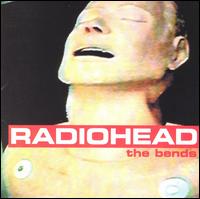
Radiohead - The Bends
(1995)
In 1993, Radiohead was thrust into
popularity with the self-deprecating single "Creep," from
the group's debut Pablo Honey. Despite the albums
apocalyptic pop brilliance, nothing could have prepared
audiences for the genius that lay ahead. The Bends
was a gigantic leap from its predecessor, yet it still only
provided a glimpse into the complex sonic universe that
would be OK Computer.
The Bends
drapes noise-rock themes over Britpop structures with ease,
allowing the album to sway from anthemic rock to desperate
atmospherics. The album's title track showcases the band's
tendencies toward assailing triple-threat guitar work, while
"Fake Plastic Trees" perfectly summarizes the lyrical
anguish and desperation so often revisited by Thom Yorke.
The Bends may forever walk in the shadow of OK
Computer, but it's worth exploring, as it perfectly
captures the transitional stage of a group desperately
seeking to voice its desire to create the perfect pop song
while perpetually experimenting to avoid classification.
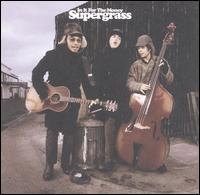
Supergrass - In It For The Money
(1997)
If ever there was a band on this Earth to
clap your hands to, it would be... well, Sly and the Family
Stone. Second on that list would be Supergrass. No one in
Britain does upbeat guitar rock better than Supergrass.
Although not an entirely original album, In It for the
Money, Supergrass' second release, is a beautiful one.
Full of lush guitar work that exudes the kind of clean
happiness you'd expect from your favorite bar of soap, the
album feels bright without getting gummy.
The title track has the kind of
bass-driven buildup that would become a trademark of the
band, and the feeling carries through the rest of the album.
Late in the Day is one of the aforementioned
hand-clap songs. While the lyrics of the songs themselves
aren't neccesarly optimistic, you'll always find yourself
tapping your feet to the tunes. Britpop, as a genre, has
never been very danceable, but In It for the Money,
and the albums to follow from Supergrass, defied that idea.
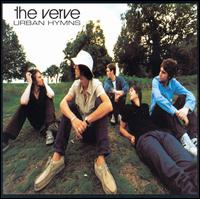
The Verve - Urban Hymns
(1997)
The Verve only lasted thee albums before
it imploded and disbanded. Urban Hymns was its swan
song, and the album was most definitely the best one of the
bunch. Britpop hadn't seen a vocalist of Richard Ashcroft's
quality since Morrissey. Like The Smiths front man, much was
publicized about Ashcroft's infighting with his writing
partner and lead guitarist Nick McCabe. Also at the heart of
their breakup was a legal battle with The Rolling Stones,
who claimed a large chunk of Urban Hymn's profits
resulted from a sample used for "Bittersweet Symphany," the
album's hit single and opening track.
While "Bittersweet Symphany" is the song
everyone remembers from the album, most forget that
Urban Hymns in its entirety is a brilliant album filled
with great tunes. It's not only one of the better albums of
the genre, but also of the decade. "Weeping Willow," "Lucky
Man," and "Catching the Butterfly" were athemic dirges that
spiraled into guitar-driven oblivion remiscent of The Stone
Roses debut. While it's unfortunate the band broke up, we
can at least be thankful that the infighting fueled the
cacophonous battle of voice and guitar that resulted in this
album. Richard Ashcroft, who later achieved a moderately
successful solo career, would never hit the same heights
again.
|
![]()
![]()
![]()
![]()
![]()
![]()

![]()

![]()
![]()
![]()









